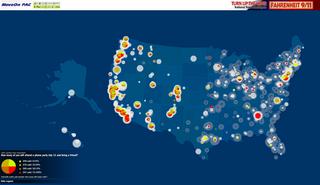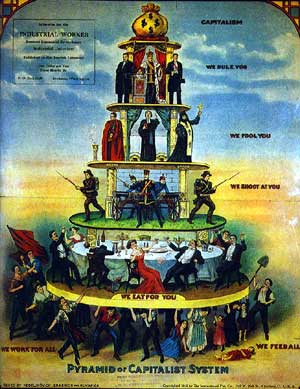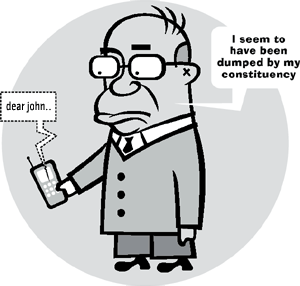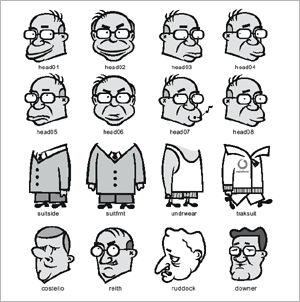www
Texting for Change
Is it still news that grassroots protest movements are using electronic media to facillitate political change? Here are two stories from the same week.
Ecuadoreans rebelled by radio, e-mail and text, Reuters, April, 23, 2005:
“Fed up with politicians, Ecuadoreans turned to local radio, text messages and the Internet to whip up a street rebellion this week that helped push their president Lucio Gutierrez out of office.
Gutierrez, a former army officer elected in late 2002, was waiting in Quito’s Brazilian embassy residence on Saturday for safe conduct to asylum in Brazil, three days after intense protests played their part in forcing him from office.
Buoyant protesters, including businessmen, housewives and students, described the demonstrations as a popular rebellion that grew through word of mouth, cellular telephone text messages and broadcasts on La Luna, a local radio station.
Many said the week-long rallies were a spontaneous reaction to frustration with what they saw as the government’s abuse of power and disappointment with leaders of all political colours....
Quito protesters took their name — the Forajidos, or the outlaws in Spanish — from criticism Gutierrez fired at them when demonstrators rallied outside his family home.
 Car windshield stickers and T-shirts carrying the logo soon appeared on Quito’s streets.
Car windshield stickers and T-shirts carrying the logo soon appeared on Quito’s streets.
When momentum started to build last week, La Luna began broadcasts calling for peaceful pan-banging demonstrations, protests with balloons and even demonstrations by lobbing rolls of paper towels.
One distributed e-mail showed an animated image of pots banging on the screen.
La Luna, a small independent Quito FM radio station that has a history of questioning the government, was key in mobilizing the rallies.
‘People came here to denounce things. When it started to get big the politicians turned up, but the people just shouted at them to get out,’ Tobar said.
As protests grew the Gutierrez government blocked La Luna’s signal, Tobar said, a charge the former government dismissed. Demonstrators began sending text messages with details of rallies when La Luna went briefly off the air.
Outside the Brazilian embassy residence, protesters have rallied for three days to demand their new government stop Gutierrez leaving the country. Many want to see him jailed.
La Luna blasted this week from the radio of a car parked outside the residence, keeping protesters up to date on new developments.
Gutierrez, who was jailed before for leading a coup, came to office with the popular support of the poor and Indian groups after promising populist reforms. But many said they felt betrayed by his tough economic policies.
The former government blamed Radio La Luna for fomenting violent protests on the streets and threatened legal action. But the radio station insists on its independence though manager Tobar acknowledged its open opposition to Gutierrez.”
Note the emphasis on a strong brand here, too.
Chinese cellphones fuel protest, NY Times, April 24, 2005:
“The thousands of people who poured onto the streets of China this month for the anti-Japanese protests that shook Asia were bound by nationalist anger but also by a more mundane fact: they are China’s cellphone and computer generation.
For several weeks as the protests grew larger and more unruly, China banned almost all coverage in the state media. It hardly mattered. An underground conversation was raging via e-mail, text message and instant online messaging that inflamed public opinion and served as an organizing tool for protesters.
The underground noise grew so loud that last Friday the Chinese government moved to silence it by banning the use of text messages or e-mail to organize protests. It was part of a broader curb on the anti-Japanese movement but it also seemed the Communist Party had self-interest in mind....
‘Chain letter’ e-mail and text messages urged people to boycott Japanese products or sign online petitions opposing Japanese ascension to the United Nations Security Council. Information about protests, including marching routes, was posted online or forwarded by e-mail. Banned video footage of protest violence in Shanghai could be downloaded off the Internet.
‘Text messages, instant messaging and Internet bulletin boards have been the main channels for discussing this issue,’ said Fang Xingdong, chairman of blogchina.com, a Web site for China’s growing community of bloggers. ‘Ten years ago, this would have been unthinkable.’
In Shanghai, the local police even sent out a mass text message to cellphone users the day before that city’s raucous protest. ‘We ask people to express your patriotic passion through the right channel, following the laws and maintaining order,’ the message said. Some marchers saw the message as a signal to proceed, while others took it as a warning.
In early 2003, text messaging and the Internet played a major role in helping people pass reliable information - and also unfounded rumors - about the outbreak of SARS at a time when the government was covering up the disease.
In the anti-Japan protests, people have sent old-fashioned chain letters to friends via e-mail or text message. Typical is a 23-year-old professional in Shanghai who asked to be identified for this article by her English name, Violet. She uses an instant messaging service on her work computer to communicate with 50 people on her ‘contact list.’...
About 27 percent of China’s 1.3 billion people own a cellphone, a rate that is far higher in big cities, particularly among the young. Indeed, for upwardly mobile young urbanites, cellphones and the Internet are the primary means of communication.
‘If people can mobilize in cyberspace in such a short time on this subject," said Wenran Jiang, a scholar with a specialty in China-Japan relations, "what prevents them from being mobilized on another topic, any topic, in the near future?’”
The protests eventually wrung an apology from the Prime Minister of Japan.
Oddly, while the China story made the NY Times. The Ecuador story was hardly picked up at all — and has disappeared from the swissinfo site where I first caught it. Is independent radio in Latin America not as “sexy” as cellphones in China?
A Threat to Peace, Interactive
Click-and-drag, or click on a state or icon to zoom in. Click on the water, or use the right-click menu to zoom out.
Based on the poster produced by the NYC Independent Media Center.
Built using DIY Map, with a little help from google-latlong.
An Introduction to Activism on the Internet
I’m collecting some principles, techniques, and examples of electronic advocacy into a brief introduction and overview of uses of the Internet for advocacy.
I’ve posted my draft online at http://backspace.com/action and am soliciting comments from the public.
If you’re interested, do check it out and let me know what you think. You can post comments directly to the site.
And do please circulate this Web address as you see fit.
Update February 16, 2004: I’ve revised the text, incorporated some of the feedback, and removed the DRAFT label.
Many thanks to everyone who commented. If I incorporated your comments, I added your name to the acknowledgments page.
The comments form will remain open a while longer.
Tree Trimming
Pyramid of Capitalist System, issued by Nedeljkovich, Brashich, and Kuharich in 1911.
Just one of the graphics available at http://www.iww.org/graphics/
Dear John...
A collective of communication designers in Melbourne, Australia are working to defeat the current conservative government of Prime Minister John Howard.
The site dearjohn.org targets the youth vote, inviting them to download free T-shirt transfers, screen savers, badges, posters, and stickers.
Although united by a common agenda to defeat Howard, the designers do not highlight a specific issue or push an alternative party to vote for. This is left for the audience to fill in blanks.
Literally. In addition to readymade downloads, the site hosts a variety of do-it-yourself materials, including instructions on making your own collage posters or gaffers tape T-shirts, and downloadable political clipart and “dingbats” — image fragments and caricatures you can use to assemble your political messages and media.
Feedback Loop
In March, I blogged about MoveOn’s use of interactive maps to illustrate participation in their campaign events. The maps are a great way to visualize the scale of the event and provide feedback to the participants and the media.
 In Stamen Design’s latest project for MoveOn, the map of feedback has itself become the means of participation.
In Stamen Design’s latest project for MoveOn, the map of feedback has itself become the means of participation.
On June 28, over 55,000 people in 4,600 house parties participated in an online conversation with Michael Moore about his film Fahrenheit 9/11. Moore spoke over a live, RealAudio feed while users asked questions via the map interface. User questions and responses to questions were displayed on the map in real time.
From Stamen’s press release:
“Stamen developed a live, map-based, interactive Q&A session that allows thousands of people to communicate visually via a moderated discussion. Visitors logging on can ‘see’ themselves and their submitted questions on the map, along with those of other MoveOn community members. Michael Moore, along with MoveOn directors Eli Pariser and Adam Ruben, will respond to active polls and answer questions from the online audience. The effect is both compelling and empowering. ‘If you can see yourself on the map, so much the better, because you can identify yourself as part of a large group of Americans all working towards the same thing,’ says Michal Migurski, Stamen’s Technical Lead. ‘You can get an immediate visual picture of just how widespread MoveOn’s membership is, and immediately connect with that community.’”
A archived version of the Flash file is in the works, but in the meantime, check out the screenshots in this chronology of the event.
The event also marked the launch of local voter registration and organizing drives around the country.
...
Update: The map was used again for the July 18 house parties and screenings of Outfoxed. Here are some screenshots from that event.
The Republicans are Coming...
Save the Date: Sunday, August 29, 2004.
Spread the Word: Download this graphic as a 176 Kb PDF, or a
100 px or
50 px square Web button.
Buy a T-Shirt: At http://www.cafepress.com/nornc/
Find Out More: Visit counterconvention.org, rncnotwelcome.org, or unitedforpeace.org.
Sign Up for the Mailing List!
![]() So you’re at a presentation by some kickass organization. You’re convinced by their analysis and the work they do. The rest of audience seems fired up, too. But by the end of the question and answer period it’s getting late and the energy has started to wane. Half the crowd has already trickled out by the time someone asks, “How can I get involved?”
So you’re at a presentation by some kickass organization. You’re convinced by their analysis and the work they do. The rest of audience seems fired up, too. But by the end of the question and answer period it’s getting late and the energy has started to wane. Half the crowd has already trickled out by the time someone asks, “How can I get involved?”
Only then does it come out “Oh yeah, can anyone pass around a piece of paper to get everyone’s email addresses?”
But by then it’s almost always too late. The crowd has dispersed or is too busy talking to each other.
I’ve seen this happen again and again and again. In fact, I’m guilty of it myself.
Enough! Say it with me:
“Sign Up for the Mailing List!”
It’s such a basic thing. And so very, very powerful.
While maintaining a Web site does require some special skills, maintaining an email list is easy. Whether publishing a newsletter, sending out an action alert, announcing an event, raising funds, building solidarity, or generally spreading the word, the costs for maintaining an email list are minimal. And the impact can be great.
For example:
- Using email and the Web, dockworkers in Liverpool mobilized workers around the world in a successful action against the Mersey Docks & Harbour Company
- Working for Equality & Economic Liberation used a free database tool and email to increase voter turnout in low-income neighborhoods and change welfare policy in Montana.
- The Zapatista National Liberation Army successfully resisted the Mexican military by publicizing the attacks to journalists and sympathizers in Mexico and around the world.
- Subscribers to Amnesty International’s Urgent Action Network have helped free thousands of prisoners.
- With their enormous email list, MoveOn has raised millions of dollars from their subscribers, registered tens of thousands of voters, and organized hundreds of meetings with elected officials in the U.S.
- SMS text messaging (a kind of email for cellphones) has helped topple heads of state in Spain, South Korea, and The Phillipines.
I’ve also seen four job descriptions in the last two weeks from large non-profit organizations recruiting online organizers. While these large organizations may be able to afford expensive online activist tracking database software, there are several free listserv services available to individuals and small organizations.
Steer clear of “free” services from big corporations, though. Not only are these often padded with advertisements, but Yahoo! and Topica don’t much care for the privacy or security of your users.
Below is a list of organizations that provide free email list services. They are run by activists for activists, generally staffed by volunteers and funded by donations. They generally do not include advertisements on their email lists. Many have specific policies about the types of groups they support and the types of email messages they do not. Visit: autistici.org/inventati.org, cat.org.au, communitycolo.net, interactivist.net, mutualaid.org, resist.ca, icomm.ca, nodo50.org, sindominio.
You can also set up a free announcement list on very your own Web server with phpList. It manages bounces and multiple lists very well and seems perfect for folks who are not yet ready to tackle a full-on Mailman installation.
If you do have a Web site, make sure it’s immediately clear that you do have an email list. And make it very easy for people to sign up. No need for pop-up windows — a prominent link or sign-up form will do.
Here are a couple of links to tips and tricks on using email for advocacy:
- A very basic introduction to email lists
- A more extensive list of techniques for email campaigns
- Notes on email newsletter usability
- Drafting effective subject lines
- Writing effective email action alert text
I also appreciate when an organization lets you know how an action went. Following-up an action with a brief update is a good way to build good will. MoveOn is particularly good at this.
And please only send email to people who have agreed to receive it from you. Spam from activists is sometimes called “tofu.” It’s just as nasty.
So please, please:
- Put out the sign-up sheet ahead of time. In fact, put out a couple of them.
- Pass them around early, while the event is still taking place.
- Before the end of the event, ask if everyone has signed up.
And if you don’t mind my saying so, be sure to add the email addresses you’ve collected to your listserv soon after the event. Then send your participants an email message thanking them for participating and letting them know about upcoming activities.
Paginate HTML from Word
 After ribbing David about open sourcing his content management system, I decided to put up myself. So here’s my first Free Software project: pagify is a perl script that takes the output of Microsoft Word’s “Save as Web Page...” and
After ribbing David about open sourcing his content management system, I decided to put up myself. So here’s my first Free Software project: pagify is a perl script that takes the output of Microsoft Word’s “Save as Web Page...” and
- cleans out the cruft and proprietary XML gunk,
- splits the file into HTML pages wherever a Heading 1 style appears, and
- converts endnotes into footnotes on the appropriate pages.
The World Still Says No to War
 Those little blue stickers are popping on the streets of New York again. This Saturday, on the one-year anniversary of the invasion of Iraq, millions will take to the streets to call for peace. Protests are scheduled in over 50 countries, with over 200 events planned around the United States.
Those little blue stickers are popping on the streets of New York again. This Saturday, on the one-year anniversary of the invasion of Iraq, millions will take to the streets to call for peace. Protests are scheduled in over 50 countries, with over 200 events planned around the United States.
United for Peace and Justice has made variations on their “flag” flyer template available for download with space to add details about your local event or create your own translation, and with rotated globes for events in Africa, Asia, or Europe.
By now there are plenty of downloadable flyers on the Web, but few designed for translation and personalization, while retaining a generally persistent brand. I’ve not seen another organization producing anti-war posters this user-oriented.
Except the Bush-Cheney presidential campaign.
From Wired:
“The Bush-Cheney presidential campaign disabled features of a tool on its website Thursday that pranksters were using to mock the Republican presidential ticket.
The tool originally let users generate a full-size campaign poster in PDF format, customized with a short slogan of their choice. But Bush critics began using the site to place their own snarky political messages above a Bush-Cheney ’04 logo and a disclaimer stating that the poster was paid for by Bush-Cheney ’04, Inc.”
See a handful of sample posters in this nostalgic Fash piece.





